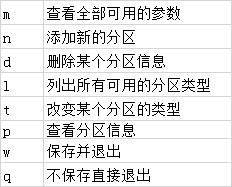新加一块硬盘,按照udev 服务命名规则,第二个被识别的SCSI 设备应该会被保存为/dev/sdb,
1.fdisk:管理磁盘分区,格式为“fdisk [磁盘名称]”
fdisk命令的参数是交互式的,可以根据需求动态调整。

举例:使用fdisk命令来管理dev/sdb1.看到提示信息后输入参数p 来查看硬盘设备内已有的分区信息,其中包括了硬盘的容量大小、扇区个数等信息:
[root@Centos ~]# fdisk /dev/sdb Welcome to fdisk (util-linux 2.23.2). Changes will remain in memory only, until you decide to write them. Be careful before using the write command. Command (m for help): p Disk /dev/sdb: 21.5 GB, 21474836480 bytes, 41943040 sectors Units = sectors of 1 * 512 = 512 bytes Sector size (logical/physical): 512 bytes / 512 bytes I/O size (minimum/optimal): 512 bytes / 512 bytes Disk label type: dos Disk identifier: 0xdb6e91a1 Device Boot Start End Blocks Id System
输入参数 n 尝试添加新的分区。系统会要求是选择继续输入参数p 来创建主分区,还是输入参数e 来创建扩展分区。这里输入参数p 来创建一个主分区:
在确认创建一个主分区后,系统要求先输入主分区的编号。主分区的编号范围是1~4,因此这里输入默认的1 就可以了。接下来系统会提示定义起始的扇区位置,这不需要改动,敲击回车键保留默认设置即可,系统会自动计算出最靠前的空闲扇区的位置。
最后,系统会要求定义分区的结束扇区位置,这其实就是要去定义整个分区的大小是多少。不用去计算扇区的个数,只需要输入+2G 即可创建出一个容量为2GB 的硬盘分区。
再次使用参数p 来查看硬盘设备中的分区信息。可以看到一个名称为/dev/sdb1、起始扇区位置为2048、结束扇区位置为4196351 的主分区了。敲击参数w 后回车,这样分区信息才是真正的写入成功。
Command (m for help): n Partition type: p primary (0 primary, 0 extended, 4 free) e extended Select (default p): p Partition number (1-4, default 1): First sector (2048-41943039, default 2048): Using default value 2048 Last sector, +sectors or +size{K,M,G} (2048-41943039, default 41943039): +2G Partition 1 of type Linux and of size 2 GiB is set Command (m for help): p Disk /dev/sdb: 21.5 GB, 21474836480 bytes, 41943040 sectors Units = sectors of 1 * 512 = 512 bytes Sector size (logical/physical): 512 bytes / 512 bytes I/O size (minimum/optimal): 512 bytes / 512 bytes Disk label type: dos Disk identifier: 0xdb6e91a1 Device Boot Start End Blocks Id System /dev/sdb1 2048 4196351 2097152 83 Linux Command (m for help): w The partition table has been altered! Calling ioctl() to re-read partition table. Syncing disks.
在上述步骤执行完毕之后,Linux 系统会自动把这个硬盘主分区抽象成/dev/sdb1 设备文件。可以使用file 命令查看该文件的属性,有些时候系统并没有自动把分区信息同步给Linux 内核,而且这种情况似乎还比较常见(但不能算作是严重的bug)。
我们可以输入partprobe 命令手动将分区信息同步到内核,而且一般推荐连续两次执行该命令,效果会更好。如果使用这个命令都无法解决问题,那么就重启计算机吧,这个杀手锏百试百灵。。。
删除分区:
[root@Centos ~]# fdisk /dev/sdb Welcome to fdisk (util-linux 2.23.2). Changes will remain in memory only, until you decide to write them. Be careful before using the write command. Command (m for help): p Disk /dev/sdb: 21.5 GB, 21474836480 bytes, 41943040 sectors Units = sectors of 1 * 512 = 512 bytes Sector size (logical/physical): 512 bytes / 512 bytes I/O size (minimum/optimal): 512 bytes / 512 bytes Disk label type: dos Disk identifier: 0xdb6e91a1 Device Boot Start End Blocks Id System /dev/sdb1 2048 4196351 2097152 83 Linux Command (m for help): d Selected partition 1 Partition 1 is deleted Command (m for help): w The partition table has been altered! Calling ioctl() to re-read partition table. Syncing disks. [root@Centos ~]# fdisk /dev/sdb Welcome to fdisk (util-linux 2.23.2). Changes will remain in memory only, until you decide to write them. Be careful before using the write command. Command (m for help): p Disk /dev/sdb: 21.5 GB, 21474836480 bytes, 41943040 sectors Units = sectors of 1 * 512 = 512 bytes Sector size (logical/physical): 512 bytes / 512 bytes I/O size (minimum/optimal): 512 bytes / 512 bytes Disk label type: dos Disk identifier: 0xdb6e91a1 Device Boot Start End Blocks Id System
如果硬件存储设备没有进行格式化,则Linux 系统无法得知怎么在其上写入数据。因此,在对存储设备进行分区后还需要进行格式化操作。
2.mkfs:格式化
在Shell 终端中输入mkfs 名后再敲击两下用于补齐命令的Tab,会有如下所示的效果
[root@Centos ~]# mkfs
mkfs mkfs.cramfs mkfs.ext3 mkfs.fat mkfs.msdos mkfs.xfs
mkfs.btrfs mkfs.ext2 mkfs.ext4 mkfs.minix mkfs.vfat
mkfs 命令地把常用的文件系统名称用后缀的方式保存成了多个命令文件,用起来也非常简单—mkfs.文件类型名称。
[root@Centos ~]# mkfs.xfs /dev/sdb1 mkfs.xfs: /dev/sdb1 appears to contain a partition table (dos). mkfs.xfs: Use the -f option to force overwrite. [root@Centos ~]# [root@Centos ~]# mkfs.xfs -f /dev/sdb1 meta-data=/dev/sdb1 isize=512 agcount=4, agsize=131072 blks = sectsz=512 attr=2, projid32bit=1 = crc=1 finobt=0, sparse=0 data = bsize=4096 blocks=524288, imaxpct=25 = sunit=0 swidth=0 blks naming =version 2 bsize=4096 ascii-ci=0 ftype=1 log =internal log bsize=4096 blocks=2560, version=2 = sectsz=512 sunit=0 blks, lazy-count=1 realtime =none extsz=4096 blocks=0, rtextents=0
上述完成了存储设备的分区和格式化操作,挂载后即可使用:首先是创建一个用于挂载设备的挂载点目录;然后使用mount 命令将存储设备与挂载点进行关联;最后使用df -h 命令来查看挂载状态和硬盘使用量信息。
[root@Centos ~]# mkdir /netFS [root@Centos ~]# mount /dev/sdb1 /netFS/ [root@Centos ~]# df -h Filesystem Size Used Avail Use% Mounted on /dev/mapper/centos_centos-root 17G 4.3G 13G 25% / devtmpfs 897M 0 897M 0% /dev tmpfs 912M 0 912M 0% /dev/shm tmpfs 912M 8.9M 903M 1% /run tmpfs 912M 0 912M 0% /sys/fs/cgroup /dev/sda1 1014M 179M 836M 18% /boot tmpfs 183M 12K 183M 1% /run/user/42 tmpfs 183M 0 183M 0% /run/user/0 /dev/sdb1 2.0G 33M 2.0G 2% /netFS
把挂载信息写入配置文件:
[root@Centos ~]# vim /etc/fstab ... /dev/sdb1 /newFS xfs default 0 0
3.存储设备顺利挂载后,接下来就可以尝试通过挂载点目录向存储设备中写入文件了。
du:查看文件数据占用量的,其格式为“du [选项][文件]”。简单来说,该命令就是用来查看一个或多个文件占用了多大的硬盘空间。
还可以使用du -sh /*命令来查看在Linux 系统根目录下所有一级目录分别占用的空间大小。
举例:先从某些目录中复制过来一批文件,然后查看这些文件总共占用了多大的容量:
[root@Centos ~]# cp -rf /etc/* /netFS/ [root@Centos ~]# ls /netFS/ abrt gconf mcelog rpc adjtime gcrypt mke2fs.conf rpm
... ...
root@Centos ~]# du -sh /netFS/ 40M /netFS/



